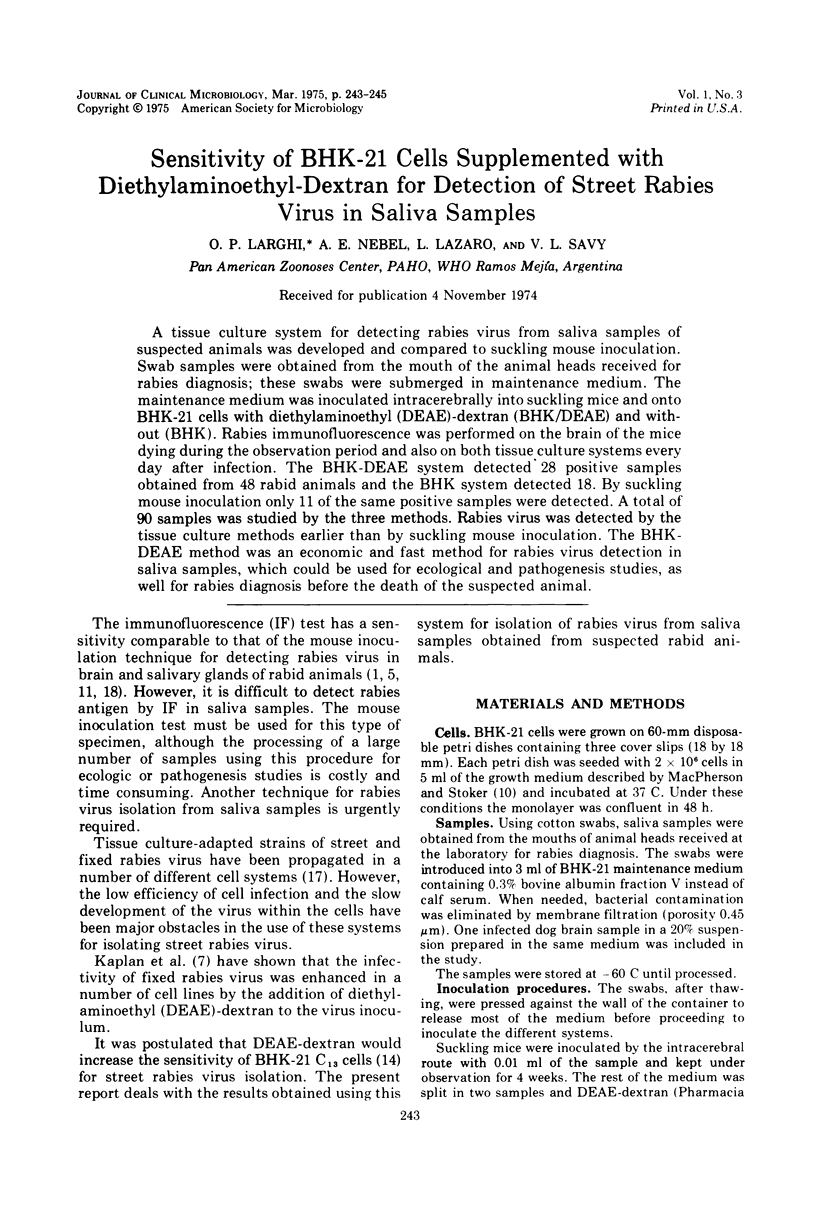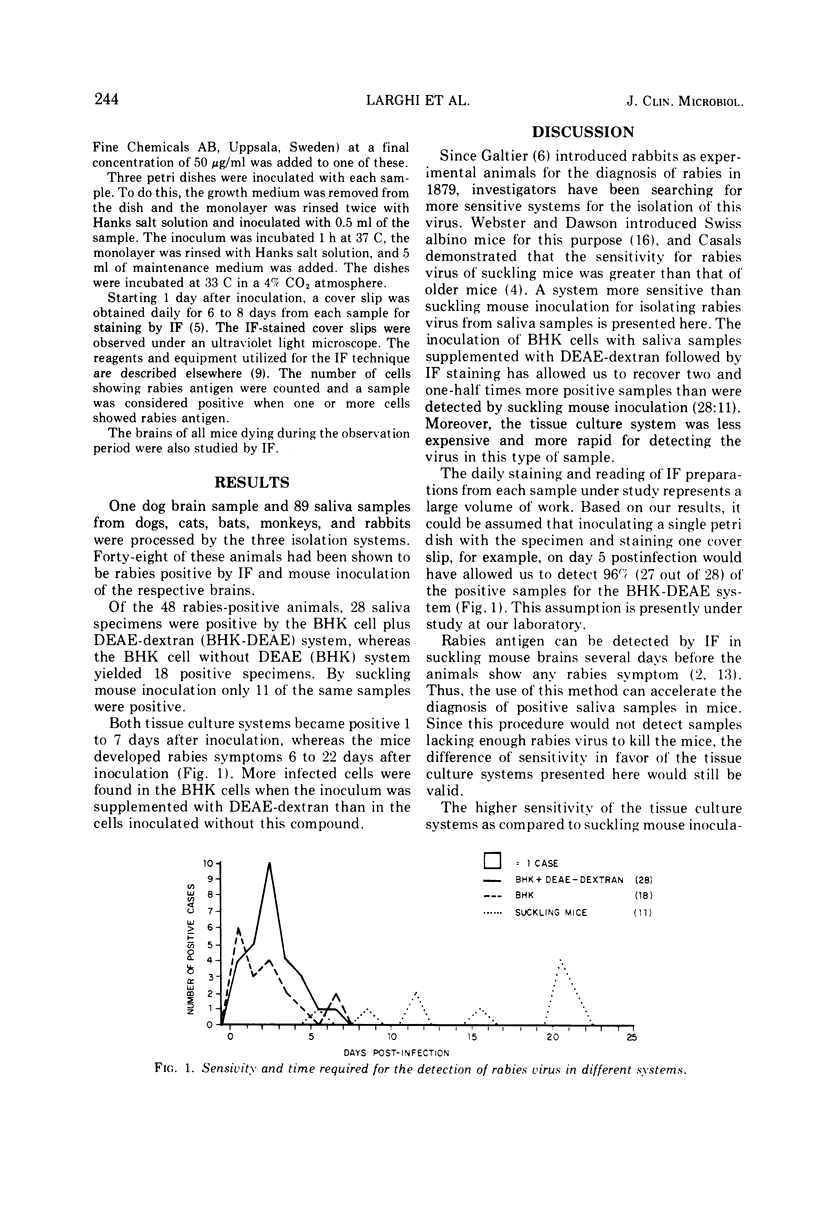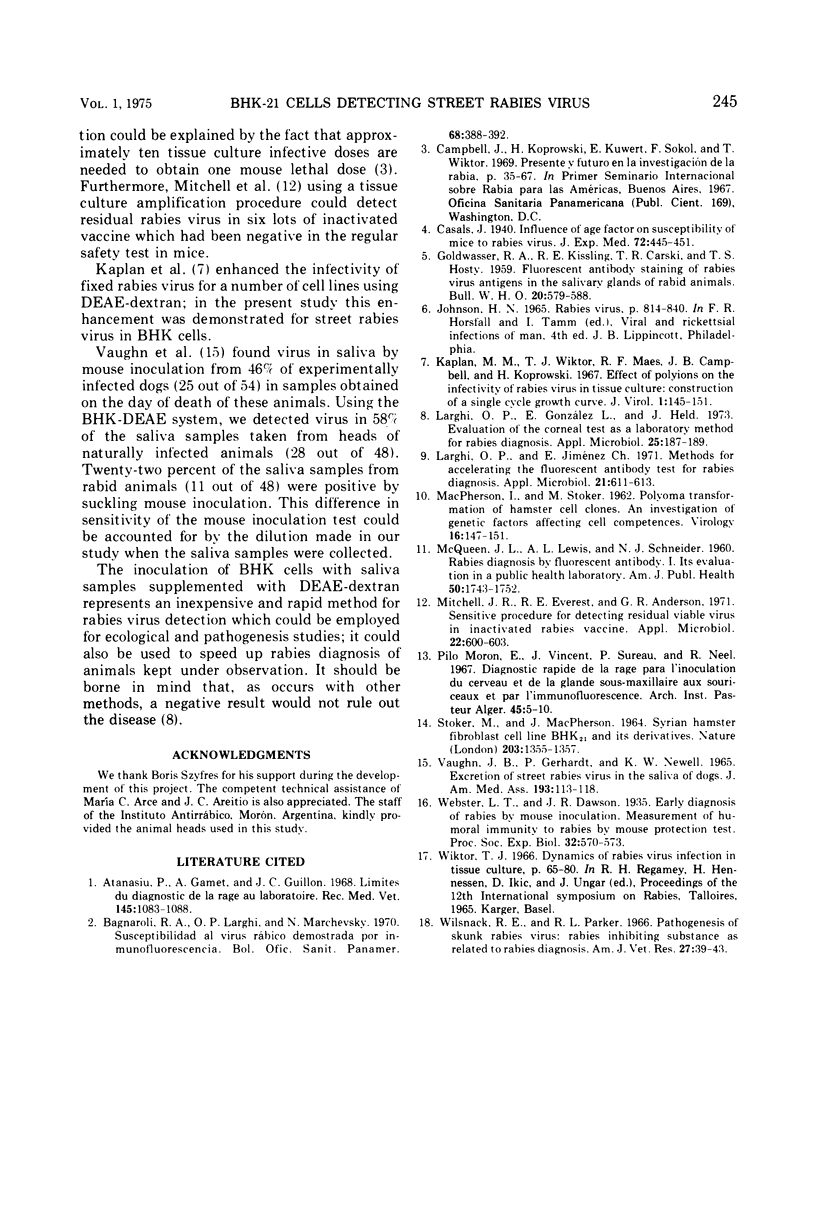Abstract
A tissue culture system for detecting rabies virus from saliva samples of suspected animals was developed and compared to suckling mouse inoculation. Swab samples were obtained from the mouth of the animal heads received for rabies diagnosis; these swabs were submerged in maintenance medium. The maintenance medium was inoculated intracerebrally into suckling mice and onto BHK-21 cells with diethylaminoethyl (DEAE)-dextran (BHK/DEAE) and without (BHK). Rabies immunofluorescence was performed on the brain of the mice dying during the observation period and also on both tissue culture systems every day after infection. The BHK-DEAE system detected 28 positive samples obtained from 48 rabid animals and the BHK system detected 18. By suckling mouse inoculation only 11 of the same positive samples were detected. A total of 90 samples was studied by the three methods. Rabies virus was detected by the tissue culture methods earlier than by suckling mouse inoculation. The BHK-DEAE method was an economic and fast method for rabies virus detection in saliva samples, which could be used for ecological and pathogenesis studies, as well for rabies diagnosis before the death of the suspected animal.
Full text
PDF


Selected References
These references are in PubMed. This may not be the complete list of references from this article.
- Bagnaroli R. A., Larghi O. P., Marchevsky N. Susceptibilidad de ratones lactantes y adultos al virus rabico demonstrada por inmunofluorescencia. Bol Oficina Sanit Panam. 1970 May;68(5):388–392. [PubMed] [Google Scholar]
- GOLDWASSER R. A., KISSLING R. E., CARSKI T. R., HOSTY T. S. Fluorescent antibody staining of rabies virus antigens in the salivary glands of rabid animals. Bull World Health Organ. 1959;20:579–588. [PMC free article] [PubMed] [Google Scholar]
- Kaplan M. M., Wiktor T. J., Maes R. F., Campbell J. B., Koprowski H. Effect of polyions on the infectivity of rabies virus in tissue culture: construction of a single-cycle growth curve. J Virol. 1967 Feb;1(1):145–151. doi: 10.1128/jvi.1.1.145-151.1967. [DOI] [PMC free article] [PubMed] [Google Scholar]
- Larghi O. P., González E., Held J. R. Evaluation of the corneal test as a laboratory method for rabies diagnosis. Appl Microbiol. 1973 Feb;25(2):187–189. doi: 10.1128/am.25.2.187-189.1973. [DOI] [PMC free article] [PubMed] [Google Scholar]
- Larghi O. P., Jimenez E. Methods for accelerating the fluorescent-antibody test for rabies diagnosis. Appl Microbiol. 1971 Apr;21(4):611–613. doi: 10.1128/am.21.4.611-613.1971. [DOI] [PMC free article] [PubMed] [Google Scholar]
- MACPHERSON I., STOKER M. Polyoma transformation of hamster cell clones--an investigation of genetic factors affecting cell competence. Virology. 1962 Feb;16:147–151. doi: 10.1016/0042-6822(62)90290-8. [DOI] [PubMed] [Google Scholar]
- MCQUEEN J. L., LEWIS A. L., SCHNEIDER N. J. Rabies diagnosis by fluorescent antibody. I. Its evaluation in a public health laboratory. Am J Public Health Nations Health. 1960 Nov;50:1743–1752. doi: 10.2105/ajph.50.11.1743. [DOI] [PMC free article] [PubMed] [Google Scholar]
- Mitchell J. R., Everest R. E., Anderson G. R. Sensitive procedure for detecting residual viable virus in inactivated rabies vaccine. Appl Microbiol. 1971 Oct;22(4):600–603. doi: 10.1128/am.22.4.600-603.1971. [DOI] [PMC free article] [PubMed] [Google Scholar]
- STOKER M., MACPHERSON I. SYRIAN HAMSTER FIBROBLAST CELL LINE BHK21 AND ITS DERIVATIVES. Nature. 1964 Sep 26;203:1355–1357. doi: 10.1038/2031355a0. [DOI] [PubMed] [Google Scholar]
- Wilsnack R. E., Parker R. L. Pathogenesis of skunk rabies virus: rabies inhibiting substance as related to rabies diagnosis. Am J Vet Res. 1966 Jan;27(116):39–43. [PubMed] [Google Scholar]


